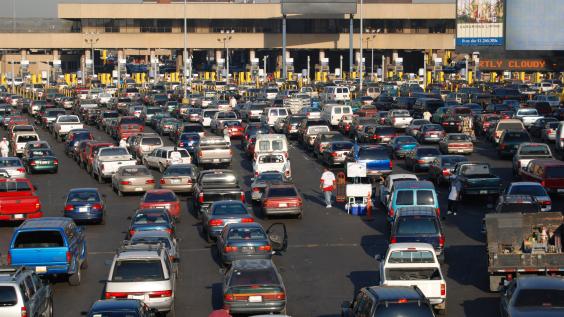Cross-border Community Organizing on the U.S.-Mexico Border

Table of Contents
U.S. Customs and Border Protection (CBP) reports U.S.-Mexico and U.S.-Canadian border wait times, which are updated hourly by each border location. CBP began formally collecting daily commercial and private passenger vehicle wait times after major delays occurred on the borders following the September 11, 2001 attacks. Generally, wait times are calculated through two methodologies, and port directors choose which to use based on the infrastructure of their port of entry. The first method is line-of-sight observation, where CBP officers look at the line visible to the naked eye or through cameras installed at the bridges, using certain landmarks and taking into account traffic volume and number of lanes open to determine their estimate. If the line surpasses the naked eye, the second methodology is to ask at least five drivers how long they waited. Nevertheless, these two methodologies have been found to be “unreliable and of limited usefulness,” coupled with inconsistent data collection to provide dependable border wait time estimations (GAO 2014; GAO 2013).
This is not news to cross-border residents at the U.S.-Mexico border. In the past, cross-border communities relied on radio talk shows that would report CBP’s wait times, and listeners would often call in and communicate the inaccuracy of the wait times reported. As a result of the inaccurate wait times reported by the official channels, online sources have become increasingly valuable for the residents of these binational communities. Furthermore, other sources like websites that provide a live video feed of the bridges also provide an estimate of the wait time to cross from Mexico to the United States. Citizens tend to rely on their knowledge and personal experiences. However, the nature and growing power of social media has now given border communities greater reach and communication to fill the gap of the flawed estimations by CBP. Facebook groups like Reporte de Puentes (Bridges Report) have been created by frequent cross-border users as a platform for border residents and users to post pictures, videos, and real-time information on the bridges and wait times. The group, with nearly 30,000 members, also shares other wait times due to traffic conditions in El Paso and Ciudad Juárez that might impact group members, along with users’ experiences crossing the border, complaints, border memes, questions, and information on lost and found visas, passports and other belongings. These kinds of efforts are also part of other border communities such as the Baja California – California region. On that side of the border, residents utilize Cómo está la línea, Tijuana (How’s the line, Tijuana), which takes a similar approach to Reporte de Puentes.
This type of local community organizing seeks to facilitate the provision of constant, reliable and timely reports for border users. It has also addressed another wait time inconsistency by CBP. CBP only reports northbound (Mexico to the United States) wait times, but does not share, and perhaps not even measure, wait times from the United States to Mexico. In recent years, CBP has increased its southbound inspections, creating huge delays in ports of entry that do not possess sufficient infrastructure to support those inspections. This situation is not unique to the Paso del Norte region; it also has been seen in the Rio Grande Valley. Mexico does not provide border wait estimates at all. While members of Reporte de Puentes and other Facebook groups continue to post pictures and report the southbound wait times, it is necessary for CBP to provide this information and deliver reliable data to improve cross-border flows to and from the United States.
Social media is playing an invaluable tool for cross-border communities. It can mobilize thousands of users to create a more reliable way to share their experiences and report their bridge wait times. U.S. Rep. Beto O’Rourke, D-El Paso, launched a social media campaign on June 24, 2016, with the hashtag #EPbridges on Twitter and Facebook to ask the public to comment on their bridge experiences, including how long they waited and how they were treated by CBP officers. This campaign aims to provide more accountability, aid in making informed decisions on investments in the region and deciding what policies should be supported to serve the interests of border communities. Thus far, the feedback from border users has been quite negative, with the majority citing long wait times to and from the United States.
These websites, social media groups and official channels are crucial for the daily activities of thousands of fronterizos. According to the Bureau of Transportation Statistics, an estimated 178.7 million people crossed from Mexico into the United States by foot and car in 2015. It is essential for all border crossers to have accurate information on wait times to fulfill their activities on either side of the border and make more efficient use of their resources, including time, when using the border.
Pamela Lizette Cruz is the research analyst for the Baker Institute Mexico Center. Her current research interests include cross-border governance, border security, institutional development and social justice.
Manuel A. Gutierrez is a Ph.D. candidate in political science at Arizona State University.
This material may be quoted or reproduced without prior permission, provided appropriate credit is given to the author and Rice University’s Baker Institute for Public Policy. The views expressed herein are those of the individual author(s), and do not necessarily represent the views of Rice University’s Baker Institute for Public Policy.


